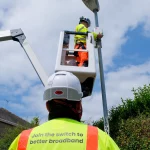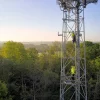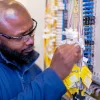LSBUD Finds UK Telecoms Industry Delivers 37.5% of Searches for Digging Work

The LSBUD (Line Search Before You Dig) organisation, which provides an online asset search facility to UK civil engineering firms for underground pipes and cables, has published their Digging Up Britain 2025 report and revealed that telecoms (broadband, mobile etc.) remains the “most active industry” when it comes to searching before digging (37.5% of all searches). But this was down from 39% last year.
The report notes that, during 2024, the number of search enquiries that passed through LSBUD’s portal reached 3.85 million (down slightly from 3.92m last year). Thanks to the roll-out of new mobile and full fibre broadband infrastructure, telecoms has remained the dominant industry in need of detailed underground mapping, amassing a total of 1,444,280 searches or 37.5% of the total (a decrease of 6% on last year) – closely followed by the water sector (27.5%) and then local authorities (11.4%).
“This drop can be put down to more properties across the UK now having access to full fibre broadband than ever before. Of course, digging work has been pivotal to full fibre’s rollout, but this momentum is beginning to slow as the focus changes from laying fibre across the length and breadth of the country to connecting individual homes to a network,” said the report.
Advertisement
In fairness, much of the slowdown actually has more to do with wider market pressures, such as rising build costs, stubbornly high interest rates and competition.
Richard Broome, Managing Director at LSBUD, said:
“The telecoms sector has been the most active when it comes to safe digging for several years, and this year is no exception. With a search being placed every five seconds during the traditional working day, the sector is ensuring the safety of workers and the surrounding public. The safe digging community is continuing to grow, and it’s clear from our data that more and more people understand the importance of searching before they dig – it’s become an automatic step.
With a record-breaking number of Users and Members now registered on our system, digging has never been safer within the UK. We want to extend our thanks to every company and individual in the telecoms sector who used our services over the last year to ensure the safety of themselves and those around them.
However, there is still so much more to do. Just 26% of telecoms operators are currently protecting their assets through a central system, leaving a huge proportion of cables unaccounted for. We would certainly like to see more progress being made in this area, however the momentum is building, which is great to see.”
The report goes on to suggest that the current trend in telecoms is expected to continue in the mid-term as “the Government’s target of 85% full fibre coverage by the end of 2025 could influence the amount of digging work conducted in 2025, with a final push to hit the target before the year’s end.” Except strictly speaking this target is for “gigabit-capable broadband” (includes other technologies as well, like coax/cable) and was hit around the end of last year (here).
The latest independent modelling from Thinkbroadband indicates that 88.4% of UK premises now have access to take gigabit broadband speeds, yet Project Gigabit’s next target (99% coverage) was recently delayed from 2030 to 2032. The delay is partly a reflection of the fact that several network operators have recently dropped out of related contracts, due in part to some of the pressures mentioned earlier.
The report concludes by noting that, currently, only 26% of GB’s telecoms network is registered on LSBUD, “leaving 1,600,000km unprotected and at risk of being hit“. But LSBUD notes some positive movement in the last year, such as with how their platform welcomed several new alternative broadband networks (toob, G.Network and AllPoints Fibre) to its member base.
Advertisement
The report doesn’t mention it, but it’s also possible that LSBUD’s operations could see some impact from the Government’s ongoing development of a National Underground Asset Register (NUAR), which represents a new digital UK map of underground pipes and cables (broadband, power, water etc.) – intended to help reduce accidental damage. The government says this is due to become “fully operational by the end of 2025“ (here).
Mark is a professional technology writer, IT consultant and computer engineer from Dorset (England), he also founded ISPreview in 1999 and enjoys analysing the latest telecoms and broadband developments. Find me on X (Twitter), Mastodon, Facebook, BlueSky, Threads.net and Linkedin.
« Virgin Media O2 UK Users Struggle to Access Secondary Email Addresses





















































@Mark
Will the NUAR effectively be a competitor to LSBUD?
I previously assumed (yes, I know that’s a foolish thing to do) that LSBUD was a not-for-profit, but I think that I might have been wrong in that assumption.
All these alt nets hitting existing services i dont know why they bother